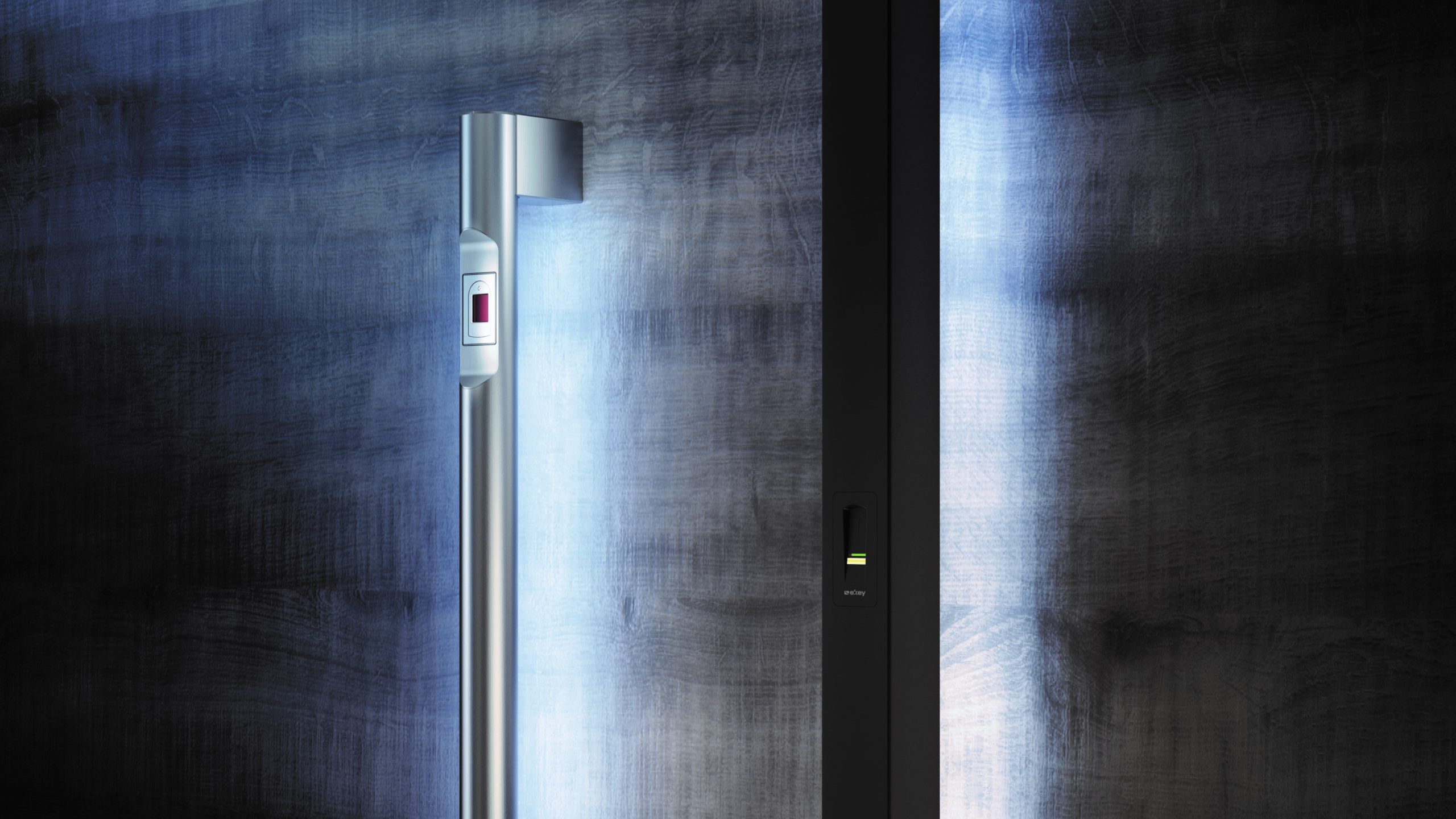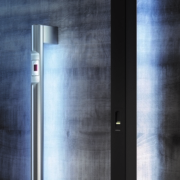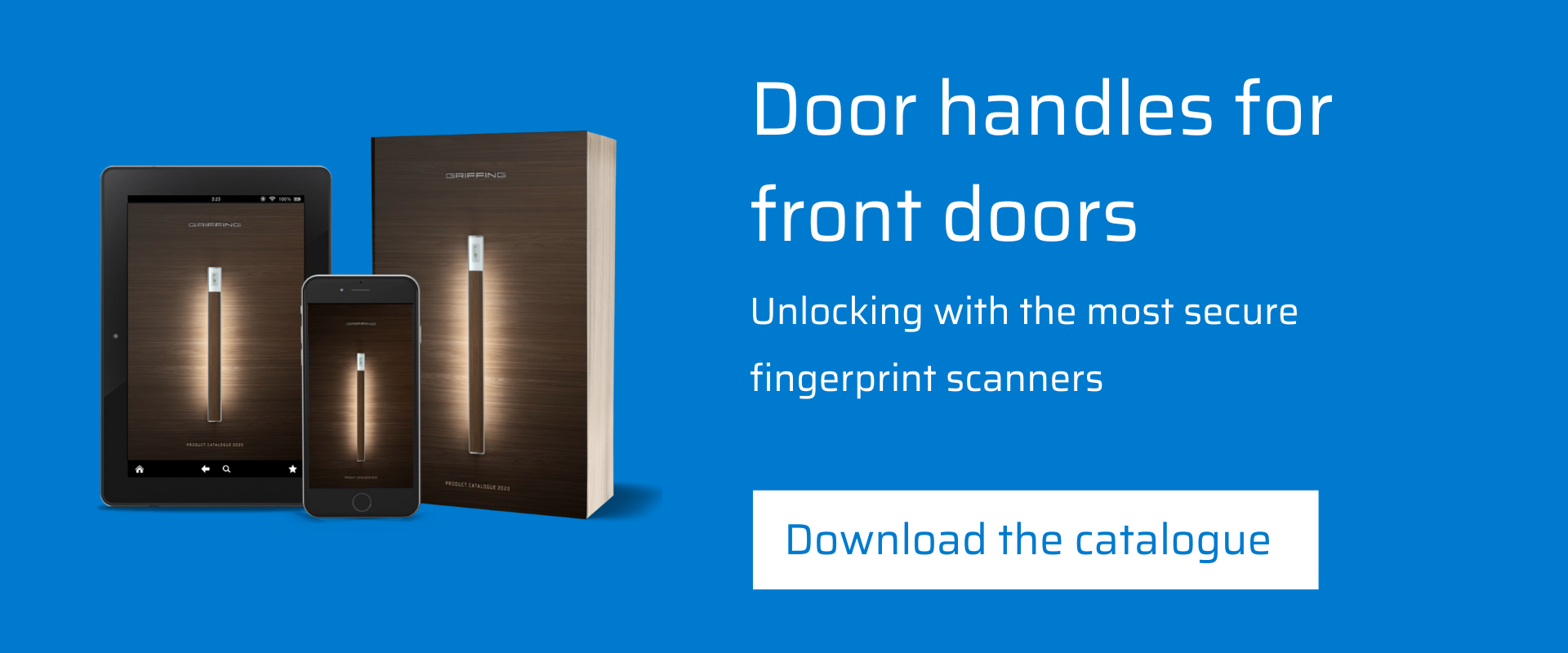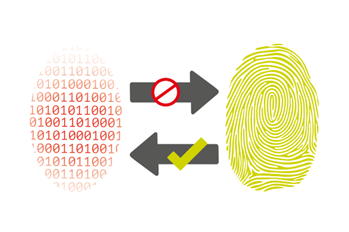
Fingerprints are increasingly widespread as a digital access key in our everyday lives. For example, we use them to unlock our phones, confirm payments, and register arrival and departure at work, so it’s no wonder more and more homes are also being fitted with fingerprint scanners. Fingerprint scanner unlocking is a modern and advanced technology, but there are a few concerns about security and technical issues.
On the security of fingerprint scanners
We talked to Igor Sterle from ekey Slovenia about the security of scanners and he answered the most frequently asked questions.
Where is the best location to install a fingerprint scanner?
We recommend fitting a scanner into the door handle, as the user touches it anyway when opening the door. Instead of a cut-out for the fingerprint scanner in the front door, manufacturers provide an additional hole at the handle bracket to install a cable passage.
The manufacturers of fingerprint scanners that Griffing collaborates with recommend fitting the scanner 155 cm from the floor. However, it can also be fitted on the front door.
Front doors suitable for connection with a fingerprint scanner
A manufacturer of front doors needs to design the door so that cables can be routed through it to connect the fingerprint scanner and the motorised lock to the electricity supply.
Converting existing doors that are not suitable for a scanner is possible, but involves a bit more work and cost. Ekey has a solution for such eventualities. An electric motor needs to be mounted on the inside of the door over the key that is already inserted in the lock and this motor then turns the key in the lock. The motor is connected wirelessly to a fingerprint scanner, which has its own power supply and then communicates with the lock, either locking or unlocking the door. The scanner can be mounted on or into the wall.
If the front door is not suitable for a scanner, but you still wish to fit a handle with a scanner:
- the door must be dismantled,
- the connection between the scanner and electric motor must be established and
- the cable must be routed from the door to the frame through a cable passage.
It is expensive to convert such doors, so it is recommended to have the door prepared in advance for the cable passage.
The front door in which a fingerprint scanner or a door handle with a scanner is to be installed must have space for a cable passage to connect the scanner to the motorised lock.
Fingerprint unlocking is one of the most secure systems
Today, biometric door unlocking systems (scanners) are among the most secure access control systems. Mechanical keys, cards, and access via numeric codes are significantly less secure than using a fingerprint, i.e. fingerprint scanners.
As the fingerprint scanner and the control unit that drives it are usually separate, the system cannot be outsmarted from the outside. The control unit is located in a secure indoor area and the system cannot be interfered with via internet since there is no connection established.
|
For example, with ekey scanners, the chance of an unauthorised person gaining access to your home is 1 in 10,000,000 provided the fingerprint images are correctly captured. Fingerprint scanners are 1,000 times more secure than the 4-digit PIN code of a bank card, and the odds of guessing a six-number lottery combination (6 out of 45) in a single try stand at 1 in 8,145,000 which is significantly higher than an unauthorised person’s entry. |
Can someone copy my fingerprint and enter my home?
As Igor Sterle says, this is only possible in James Bond films. High-quality fingerprint scanners on the market are built to recognise a live fingerprint, which means it is impossible to unlock the door with silicone fakes or copies using other technologies.
The system recognises a fingerprint as a numeric code. However, this code cannot be converted back into a fingerprint image.
How does fingerprint unlocking function if there is a power failure?
Fingerprint scanners which allow unlocking using a fingerprint and motorised lock need electricity to work. However, the customer is still provided with a mechanical key, just in case, and many manufacturers of fingerprint scanners provide uninterruptible power supply systems in case of power outages.
Such systems can run for up to a week during a power outage, powering the scanner so one can access their home, meaning that panic is unnecessary in the event of a power cut. Also important – in the event of a power failure, the doors cannot open by themselves.
What if technical faults occur?
The first question we ask ourselves is whether we, as users, can destroy the fingerprint scanner. To do so when using the product as recommended is almost impossible.
However, technical faults can happen, after all nothing in life is 100% secure. First-rate scanner manufacturers are committed to quick resolution and are available to help at virtually any time.
An example of a fault would be a lightning strike during a severe thunderstorm. If the scanner is damaged, it is simply sent for replacement or repair, which, at ekey, takes only a day or so.
And even in cases of technical failure, customers have a key to enable access their home.
Something is expensive when it costs more than we are willing to pay for it
The cost of fingerprint unlocking systems has reduced significantly and is now roughly equivalent to that of card or numeric code security systems.
Prices vary depending on the market and manufacturer, however, high quality scanners for installation in door handles can be found at prices ranging between €300 and €600.
Igor Sterle from ekey Slovenia states that something is expensive when it costs more than we are willing to pay for it: “It is true, however, that we also need to think about all of the other priorities in our lives. If someone is building a new house and runs out of money for the façade, then they of course won’t prioritise the scanner over the façade.”






